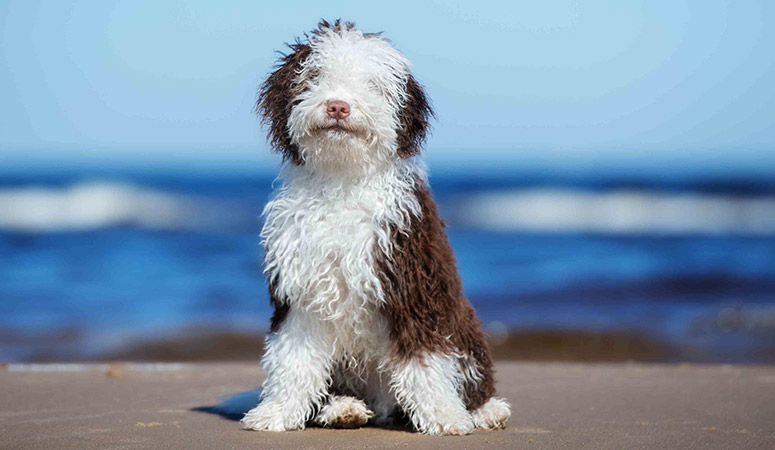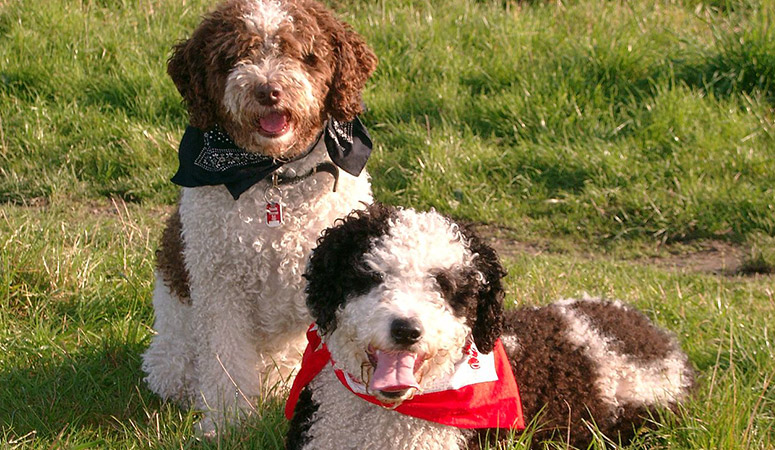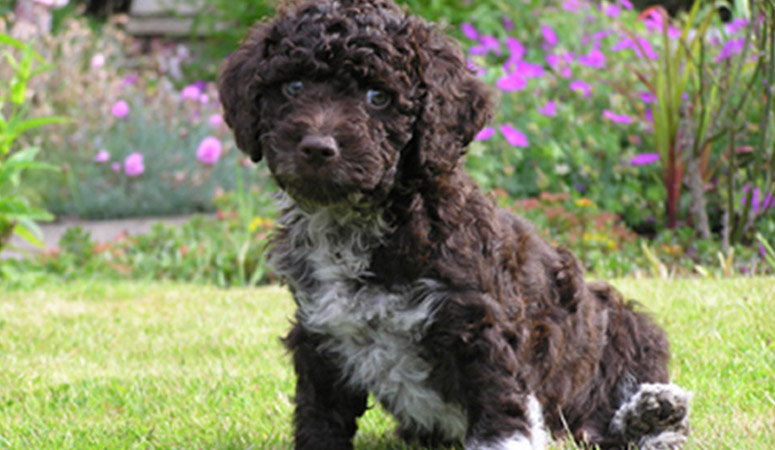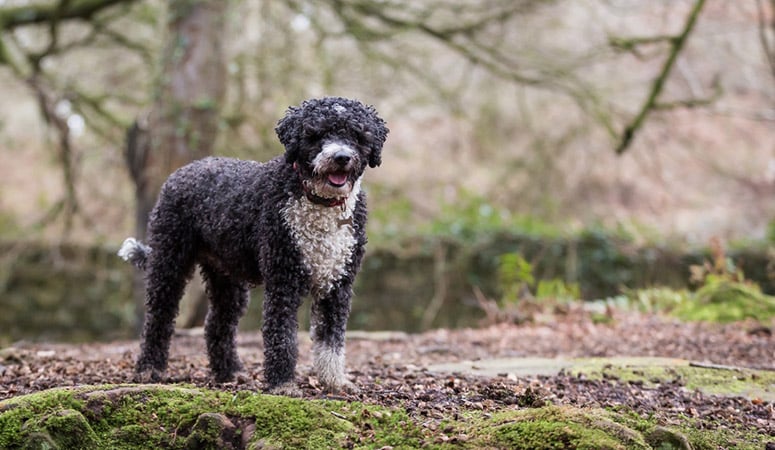Spanish Water Dog
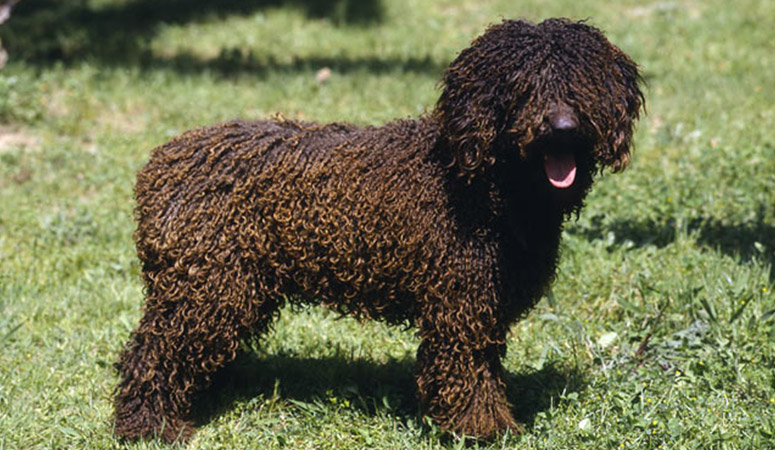
The Spanish Water Dog has naturally curly and wooly head to toe. They are bred as a general purpose sheepdog and guard, but sometimes also as a gundog with a medium size and they are skilled at retrieval from water. Their movement is effortless and ground covering, with good reach and drive. The charming, lovely character and solidly built make them good family companions and vigilant watchdogs.
| Other Names | Perro de Agua Espanol, Turco Andaluz |
| Color | Black, Black & White, Brown, Brown & White, White & Brown |
| Height | Male: 17.5-19.75 inches, Female: 15.75-18 inches. |
| Weight | Male: 40-49 pounds, Female: 31-40 pounds. |
| Life Span | 12-14 years |
| Personality | Playful but also Work-Oriented. Very Active and Upbeat. |
| Exercise | Needs Lots of Activity |
| Origin |
| Popularity | #144 |
| Groom Needs | Specialty/Professional |
| Kids Friendly | Yes with supervision |
| Dog Friendly | Yes with supervision |
| Watch Dog | Yes |
| Family Dog | |
| Litter Size | 4-6 puppies |
Spanish Water Dog Pictures
Spanish Water Dog Video
Introduction
Even though he is big, he is so cute, the Spanish Water Dog. He is strong and looks just like a sheep with his curly, woolly hair. The colours of his woolly coat can come in white, chestnut, and black, but they can also be bicolored like white and brown, or white and black. You get even tricolored ones like black and tan. With their woolly coat, they are capable of enduring cold and hot weather, and they love swimming, as their name suggests! Their coats should never be brushed or combed. If you can’t manage the grooming, take them to professionals to shear the dog. In any case, he should be sheared once a year. You can bathe this dog, but not often. He is highly intelligent, versatile and well-balanced, making a highly devoted family dog and easy to train too. He makes a good watchdog too, with good vocal cords, using them to protect his property and territory. He will need socialization training from a young age because although he makes a wonderful companion, he shouldn’t be left unsupervised with small children. He certainly needs plenty of physical and mental stimulation because he is used to being used as a rescue dog or a bomb detection dog, therapy work, and so on. However, he shouldn’t be over-exercised to avoid joint and bone problems. He is around 20 inches at the shoulders and weighs around 40 pounds.
Living with Spanish Water Dog
With single coat, meaning, the Spanish Water Dog require minimal grooming. The most important basic guidelines for a properly groomed Spanish Water Dog are that the coat is never to be brushed, and it should be the same length all over.
The Spanish Water Dog was traditionally sheared once per year, along with the sheep, but now their coat is maintained between one and five inches in length. SWD puppies should be trimmed for the first time at around the age of 4 months.
SWDs should be bathed only when dirty in lukewarm water with a neutral shampoo, but never use human shampoo. And they should be allowed to air dry.
He doesn’t shed heavily, although he does lose hairs, just as people do. Frequency of clipping is up to the owner’s preference for the length of hair on their dog, with some owners choosing to let it grow for many months to form cords.
The cording process does take ongoing attention and some expertise, which is different from that of other corded breeds, owners wanting to undertake this for the first time are encouraged to find someone experienced with Spanish Water Dog Coats.
Nails should be trimmed once per month if the dog does not wear down the toenails naturally.
Check the ears on a weekly basis for signs of infection, irritation, or wax build up. Cleanse regularly with a veterinarian-approved cleanser and cotton ball. Brush the teeth at least once per week to prevent tartar buildup and fight gum disease.
The Spanish Water Dog needs daily mental and physical challenges that can be met with a long walk, jog, or vigorous games, plus activities like agility. Without regular stimulation, the breed can become a couch potato or show nuisance behaviors such as excessive barking.
Spanish Water Dogs benefit from a good run at least once a day. With their moderate size and natural athleticism, they enjoy being active, but they also have a good “off switch” for more settled time at home.
SWDs are usually strong swimmers, and playing fetch in the water is a great way to burn off energy without the risk of injury that repetitive impact through retrieving on land can cause.
Once they have reached full maturity and the bone growth plates are closed, they have the capacity for lengthy, strenuous exercise and make great companions for activities such as running, hiking, or snow-shoeing.
The Spanish Water Dog should be offered a dog food that has been formulated to meet the energy requirements of large-breed dogs.
Any diet should be appropriate to the dog’s age, size, activity level and metabolism. The quality of dog food you buy also makes a difference — the better the dog food, the further it will go toward nourishing your dog and the less of it you’ll need to shake into your dog’s bowl.
It’s best to feed a mature dog twice a day, once in the morning and then again in the evening, making sure it’s good quality food that meets all their nutritional requirements. SWDs are also strong chewers and enjoy a substantial knuckle-bone from time to time, which may also help to keep their teeth clean.
Some dogs are prone to getting overweight, so watch your dog’s calorie consumption and weight level. Treats can be an important aid in training, but giving too many can cause obesity.
Clean, fresh water should be available at all times.
Learn about which human foods are safe for dogs, and which are not. Check with your vet if you have any concerns about your dog’s weight or diet.
All dogs have the potential to develop genetic health problems, just as all people have the potential to inherit a particular disease. Breed health concerns may include eye problems, hip dysplasia, progressive retinal atrophy, hypothyroidism, exocrine pancreatic insufficiency, allergies, cataracts, etc.
The single, curly coat often leads people to believe that the SWD is hypoallergenic, but all dogs produce allergens to some extent in their dander, saliva and urine. If you have allergies, you should spend time with several Spanish Water Dogs to determine whether you react to them.
Not all Reds will get any or all of these diseases, but it’s important to be aware of them if you’re considering this breed.
As with all breeds, the Spanish Water Dog’s ears should be checked regularly for signs of infection, and the teeth should be brushed often, ideally every day, using a toothpaste formulated for dogs.
There are several health tests considerations specific to the breed, such as hip evaluation and ophthalmologist evaluation. Responsible breeders test all breeding stock for conditions that can affect the breed. Regular visits to the vet for checkups and parasite control help to ensure the dog a long, healthy life.
Total Annual Cost: $2889
Cost is estimated for the first year and may vary depending on many factors, such as dog food, health care, leash, collar, licensing, possible fencing, crates, training and obedience classes, dog-walking, grooming, treats, toys, flea, tick, and heart-worm meds, microchips, etc.
This is a highly intelligent and active breed both mentally and physically, so it typically responds well to training. SWDs are extremely biddable and willing to please and are showing themselves to be highly capable and very versatile.
The temperament of the Spanish Water Dog deserves special consideration. These dogs are very loyal to their owners but can be quite wary of strangers. Ongoing socialization as well as positive new experiences are essential from an early age, which can help them get along well with children and household pets.
They thrive on the problem-solving nature of positive training using a clicker or similar training style. Harsh training methods may cause the SWD to lose his enthusiasm for the tasks asked of him, and he may “shut down.”
Spanish Water Dogs are also a highly active breed so, especially if you intend to train your dog for herding or other dog sports, you may want to consider an active breed formula. Potential owners are reminded that as herding dogs, some SWDs have a very high prey drive. They need a reliable recall. Even with diligent training, some will not be able to resist the temptation of a squirrel, rabbit, or deer.
History
The Spanish Water Dog originates from Andalusia. Some say Turkish merchants brought the dog to the southern Iberian Peninsula along with their livestock, moving around the Mediterranean area. Others claim they come from North Africa. There is documentation of a woolly coated Water Dog on the Iberian Peninsula in 1110 AD. It is generally accepted that these woolly coated dogs were the ancestors of water dogs.
In Spain, the Water Dog was primarily used for herding sheep and goats and for hunting game and waterfowl.
The French aristocracy admired the Water Dog, bringing them to Paris. There are many paintings depicting French and Spanish Royalty with Water Dogs which can be seen in “La Palacio de Granja” in Segovia.
The Spanish Water Dog can still be found working in the mountains of southern Andalucia herding goat and sheep as they have been doing for the last 1000 years. They are also used for modern tasks such as Search and Rescue and bomb-sniffing by the Spanish government.
The dog was officially recognized in America by the United Kennel Club in 2001.
The American Kennel Club approved this breed in 2009 and they were officially recognized in 2015.
Helpful Information
Breed Club: SPANISH WATER DOG CLUB OF AMERICA
Breed Club Link: https://www.swdclub.org/
Breed Club Rescue: SWDCA Rescue
Breed Club Rescue Link: https://www.swdclub.org/swdcarescue.html

